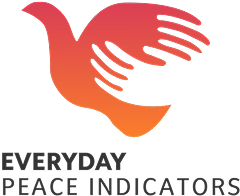What is EPI?
- Home
- What is EPI?
We partner with communities to define and measure peace
At Everyday Peace Indicators, we believe that peace and justice are best understood through the lens of everyday life. We collaborate with local communities to develop grassroots indicators that reflect how people experience and define complex concepts like reconciliation and social justice. These community-generated insights inform peacebuilding in diverse contexts—from Afghanistan to Colombia and beyond.
Our Mission
EPI conducts participatory research and evaluation in partnership with communities affected by conflict and builds bridges between diverse actors working on peace and conflict issues to inform peacebuilding practice, policy and scholarship.
Our Vision
We envision a world where decision-makers and community members work together to transform violent conflicts and build peaceful, equitable and just societies informed by the everyday lived experiences of people and communities.

What is the EPI Approach?
We work directly with communities to develop people-centered indicators that reflect lived realities.
Our participatory research approach gathers data at the village or neighborhood level through collaborative methods. We combine quantitative surveys, qualitative interviews and Photovoice techniques to explore how individuals understand and experience these complex social concepts.
By generating participatory statistics, our process empowers communities to define and assess peace on their own terms—ensuring that local perspectives shape the way we build peace.
Our Four-Staged Approach


Co-create Indicator Lists
We start by holding focus groups with a representative group of men, women, and youth to co-create lists of indicators that reflect their lived experiences and understanding of peace.


Verify and Visualize
These lists are then verified and prioritized through town hall meetings with the broader community. In some cases, we incorporate photovoice—a visual method that allows participants to document and share their perceptions of peace through photography.


Design, Monitor and Evaluate
These everyday indicators are applied to design and evaluate the effectiveness of programs and policies, ensuring that they align with the community's specific needs.


Measure Changes in Communities’ Perceptions
We track shifts in how people perceive peace, justice and other social concepts over time, providing insights into the evolving dynamics within the community.
Everyday indicators are not abstract metrics—they are tangible signs rooted in daily life, revealing what peace truly means to everyday people.
What makes us unique?
Defining and measuring peace is no small task. The peacebuilding field often relies on generic metrics chosen by policymakers and experts, overlooking the lived experiences of communities.
Our innovative, participatory approach changes this. Instead of using generic metrics, we empower communities to identify their own indicators of peace and justice, highlighting local needs, priorities and solutions.
Everyday indicators offer rich, nuanced insights into how peace is experienced in daily life—insights that are frequently missed by donors, practitioners and policymakers. By placing communities at the center of peace measurement, our approach shifts power away from top-down frameworks and toward local agency.

The EPI approach is unique:
Ownership
Indicators come directly from community members, fostering a sense of ownership.
Scope
Community members choose meaningful indicators, reflecting wider societal dynamics.
Empowerment
Communities have a say in how their indicators are presented and can use the indicators to advocate for change in their neighborhoods.





Accuracy
Indicators that are derived from real, everyday experiences are more accurate.
Scale
Indicators help us understand differences within and between communities.
The EPI approach is unique:

Ownership
Indicators come directly from community members, fostering a sense of ownership.

Scope
Community members choose meaningful indicators, reflecting wider societal dynamics.

Empowerment
Communities have a say in how their indicators are presented and can use the indicators to advocate for change in their neighborhoods.

Accuracy
Indicators that are derived from real, everyday experiences are more accurate.

Scale
Indicators help us understand differences within and between communities.
Our Impact
Robust Community-Generated Data
Our database, containing over 17,000 indicators from nine countries, has informed 35+ publications, been cited in over 3,000 articles, and influenced national and international discussions.
Amplifying Community Voices
Our database, containing over 17,000 indicators from nine countries, has informed 35+ publications, been cited in over 3,000 articles, and influenced national and international discussions.
Increasing Relevance and Effectiveness
By aligning with community priorities, our approach ensures peacebuilding initiatives are more relevant and effective.
Transforming Peacebuilding Policy and Practice
We champion participatory methods that revolutionize how practitioners and donors interact with conflict-affected communities. Engaging in pivotal discussions about inclusivity in research and monitoring & evaluation, we ensure that peacebuilding efforts authentically represent diverse voices and real-life experiences. Supported by partners and funders such as the UN, USAID, and Humanity United, our initiatives have catalyzed the widespread adoption of "everyday peace" concepts. This ensures policies and programs are finely tuned to local contexts and needs.
Our participatory approach ensures that local perspectives shape peacebuilding practices.
The EPI research findings played a crucial role in identifying the fundamental priorities for everyday reconciliation in the communities we worked in. It assisted us in collaborating with stakeholders and grantees and the research facilitated the co-creation of strategies, project formulation, and successful implementation
Global Communities
Sri Lanka and EPI Partner
What I would single out as the most striking thing about the EPI approach was that it is a truly participatory approach. Everybody tries to be participatory these days, it is kind of a buzz word too, but in reality it always ends up not being implemented as imagined. When it comes to EPI what I really liked was that the participatory idea is really realized from the very beginning until the end.
Emina Hasanagić
MEAL Officer, People in Need, Mostar and EPI Partner
Our Team
Our Partners and Sponsors










